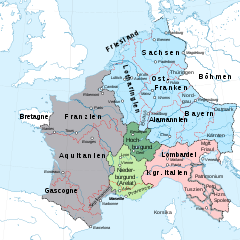
Arnulf of Carinthia was the duke of Carinthia who overthrew his uncle Emperor Charles the Fat to become the Carolingian king of East Francia from 887, the disputed king of Italy from 894 and the disputed emperor from February 22, 896, until his death at Regensburg, Bavaria.
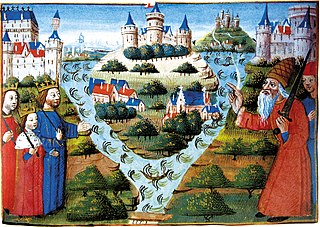
The Treaty of Verdun, agreed in August 843, divided the Frankish Empire into three kingdoms between Lothair I, Louis II and Charles II, the surviving sons of the emperor Louis I, the son and successor of Charlemagne. The treaty was concluded following almost three years of civil war and was the culmination of negotiations lasting more than a year. It was the first in a series of partitions contributing to the dissolution of the empire created by Charlemagne and has been seen as foreshadowing the formation of many of the modern countries of western Europe.
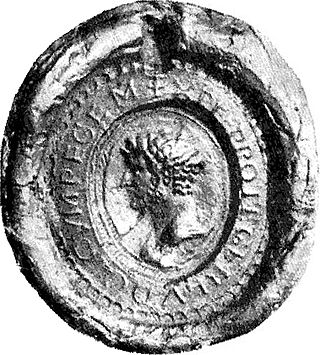
Louis the German, also known as Louis II of Germany, was the first king of East Francia, and ruled from 843 to 876 AD. Grandson of emperor Charlemagne and the third son of Louis the Pious, emperor of Francia, and his first wife, Ermengarde of Hesbaye, he received the appellation Germanicus shortly after his death, when East Francia became known as the kingdom of Germany.

Charles the Bald, also known as Charles II, was a 9th-century king of West Francia (843–877), King of Italy (875–877) and emperor of the Carolingian Empire (875–877). After a series of civil wars during the reign of his father, Louis the Pious, Charles succeeded, by the Treaty of Verdun (843), in acquiring the western third of the empire. He was a grandson of Charlemagne and the youngest son of Louis the Pious by his second wife, Judith.
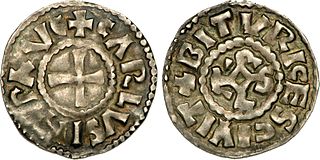
Charles III, called the Simple or the Straightforward, was the king of West Francia from 898 until 922 and the king of Lotharingia from 911 until 919–923. He was a member of the Carolingian dynasty.

Carloman II was the King of West Francia from 879 until his death. A member of the Carolingian dynasty, he and his elder brother, Louis III, divided the kingdom between themselves and ruled jointly until the latter's death in 882. Thereafter Carloman ruled alone until his own death. He was the second son of King Louis the Stammerer and Queen Ansgarde.

Lothair I was a 9th-century Carolingian emperor and king of Italy (818–855) and Middle Francia (843–855).

Lotharingia was a medieval successor kingdom of the Carolingian Empire. It comprised present-day Lorraine (France), Luxembourg, Saarland (Germany), Netherlands, and the eastern half of Belgium, along with parts of today's North Rhine-Westphalia (Germany), Rhineland-Palatinate (Germany) and Nord (France). It was named after King Lothair II, who received this territory after the Kingdom of Middle Francia of his father, Lothair I, had been divided among his three sons in 855.

Louis III was King of West Francia from 879 until his death in 882. He succeeded his father Louis the Stammerer, and ruled over West Francia in tandem with his brother Carloman II. Louis controlled the northern part of West Francia (Neustria), including the capital of Paris, while Carloman controlled the southern portion (Aquitania). Louis ruled from March 880 to 5 August 882, when he died and left the rest of West Francia to his brother. His short reign was profoundly influenced by his military success, including his defeating Vikings in August 881.
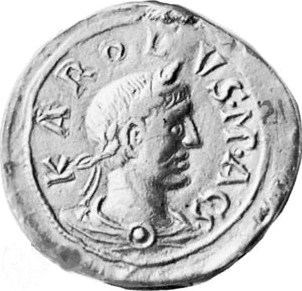
Charles III, also known as Charles the Fat, was the emperor of the Carolingian Empire from 881 to 887. A member of the Carolingian dynasty, Charles was the youngest son of Louis the German and Hemma, and a great-grandson of Charlemagne. He was the last Carolingian emperor of legitimate birth and the last to rule a united kingdom of the Franks.

The Treaty of Mersen or Meerssen, concluded on 8 August 870, was a treaty to partition the realm of Lothair II, known as Lotharingia, by his uncles Louis the German of East Francia and Charles the Bald of West Francia, the two surviving sons of Emperor Louis I the Pious. The treaty followed an earlier treaty of Prüm which had split Middle Francia between Lothair I's sons after his death in 855.

East Francia or the Kingdom of the East Franks was a successor state of Charlemagne's empire ruled by the Carolingian dynasty until 911. It was created through the Treaty of Verdun (843) which divided the former empire into three kingdoms.

Boso was a Frankish nobleman of the Bosonid family who was related to the Carolingian dynasty and who rose to become King of Lower Burgundy and Provence.
Kingdom of Burgundy was a name given to various states located in Western Europe during the Middle Ages. The historical Burgundy correlates with the border area of France and Switzerland and includes the major modern cities of Geneva and Lyon.

The Kingdom of Upper Burgundy was a Frankish dominion established in 888 by the Welf king Rudolph I of Burgundy within the territory of former Middle Francia. It grew out of the Carolingian margraviate of Transjurane Burgundy southeast of the Jura Mountains together with the adjacent County of Burgundy (Franche-Comté) in the northwest. The adjective 'upper' refers to its location upstream in the Rhône river valley, as distinct from Lower Burgundy and also from the Duchy of Burgundy west of the Saône river. Upper Burgundy reunited with the Kingdom of Lower Burgundy in 933 to form the Kingdom of Burgundy, later known as Kingdom of Arles or Arelat.
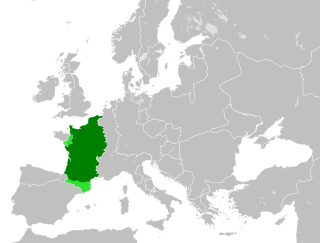
In medieval historiography, West Francia or the Kingdom of the West Franks constitutes the initial stage of the Kingdom of France and extends from the year 843, from the Treaty of Verdun, to 987, the beginning of the Capetian dynasty. It was created from the division of the Carolingian Empire following the death of Louis the Pious, with its neighbor East Francia eventually evolving into the Kingdom of Germany.

Middle Francia was a short-lived Frankish kingdom which was created in 843 by the Treaty of Verdun after an intermittent civil war between the grandsons of Charlemagne resulted in division of the united empire. Middle Francia was allocated to emperor Lothair I, the eldest son and successor of emperor Louis the Pious. His realm contained the imperial cities of Aachen and Pavia, but lacked any geographic or cultural cohesion, which prevented it from surviving and forming a nucleus of a larger state, as was the case with West Francia and East Francia.
Hugh or Hugo was an illegitimate son of Lothair II, king of Lotharingia, by his concubine Waldrada. His father made him Duke of Alsace in 867.

Louis the Younger, sometimes called Louis the Saxon or Louis III, was the second eldest of the three sons of Louis the German and Hemma. He succeeded his father as the King of Eastern Francia on 28 August 876 and his elder brother Carloman as King of Bavaria from 879 to 882. He died in 882 and was succeeded in all his territories, which encompassed most of East Francia, by his younger brother, Charles the Fat, already king of Italy and emperor.

The Treaty of Prüm, concluded on 19 September 855, was the second of the partition treaties of the Carolingian Empire. As Emperor Lothair I was approaching death, he divided his realm of Middle Francia among his three sons.
